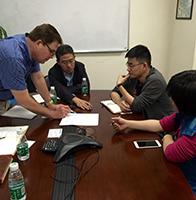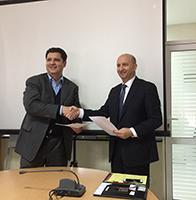Market development is vital to U.S. agriculture and is the core work of the U.S. Grains Council’s (USGC) efforts to develop new export markets for U.S. feed grains and their related co-products.
With nearly 95 percent of the world’s consumers living outside the United States, global markets offer significant growth opportunities for U.S. agriculture. These markets are evolving and changing continually, so it’s critical to work actively to find and build new demand for U.S. barley, corn, sorghum and related products, including ethanol and distiller’s dried grains with solubles (DDGS).
Growing Demand for U.S. Feed Grains
All of the programs that the Council conducts are centered on market development for U.S. feed grains and co-products in some form or fashion.
“While we have people who work on specific issues, such as trade policy, biotechnology and even media, we all work together and everything that we do is to develop international markets,� said Cary Sifferath, USGC Senior Director of Global Programs, who oversees the direction of the organization’s 10 international offices.
“Overcoming constraints to trade of U.S. feed grains to any given market is the pure definition of market development, and that is the soul of what the Council does day-to-day.�
USGC market development programs work to build demand for U.S. feed grains and their co-products, and are made possible by support from U.S. farmers, agribusinesses and the USDA’s Foreign Agricultural Service (FAS) funds.
“Using farmer-funded checkoff dollars along with funds from USDA is a great public-private partnership,� said Kurt Shultz, USGC Senior Director of Global Strategies, who works with the international offices to develop and implement short-term and long-term marketing programs. “We go and do things that private industry can’t do on their own, and do it on behalf of the whole industry.�
Market Development Strategies
USGC’s market development programs are built out of short-term and long-term strategies that are integrated and tailored to each country. Many of the programs are multi-year, so each approach is managed based on what will work in the specific market.
“Market development takes a combination of short-term marketing with long-term commitment,� Shultz said. “We recently had to adjust a short-term strategy when there was a change in dynamics with DDGS and sorghum exports to China. The country needed more sorghum, so we shifted the funding and programming away from other areas.�
Shultz described these market development strategies as “tools in a toolbox.�
The Council’s market development activities can include a wide variety of programs and outreach like trade teams, missions, providing information, research, conferences, trade shows, technical education, contracting education, trade policy and local capacity building.
Trade teams and missions are two collaborating activities that bring together current and potential buyers of U.S. feed grains and co-products with U.S. sellers. Trade teams bring groups of overseas stakeholders to the United States to see production practices and the movement of grain through the marketing channel. Missions – groups of U.S. farmers, agribusiness professionals, researchers and others – travel overseas to see international markets firsthand, take part in USGC programs and share how they are personally involved with U.S. feed grains with those making buying decisions.
Most importantly, trade teams and missions help develop face-to-face relationships between international buyers, U.S. feed grain producers and the agribusinesses that are involved in the production, transportation, storage and marketing of those grains and their related co-products.
Providing marketing information and research through seminars, conferences and trade shows are other important market development tools the Council utilizes to help ensure customers what they need to be comfortable buying from the United States.
“Everyone has marketing information, but it doesn’t necessarily mean they use what you have or what you give them,� Shultz said. “So we engage our customers directly with educational seminars and by following up with trade teams and missions to integrate together.�
Hosting conferences and trade shows allows for research and information to be dispersed and offers opportunities for valuable face-to-face conversations. They are also great avenues for becoming familiar with potential, new markets and building key relationships.
The Council’s technical education programs teach livestock and poultry producers how to use feed grains effectively and manage their operations efficiently. Other educational programming focuses on the U.S. marketing system, including financing, government programs, U.S. feed grains quality and prices.
The organization’s trade policy initiatives identify foreign barriers to U.S. feed grains exports. Policy work happens out of the Council’s headquarters in Washington, D.C., where staff and member-leaders can work with the U.S. government and related organizations to develop a clear, consistent export policy that responds to changing international market needs. USGC staff in overseas offices also work closely with local governments as needed.
Building Capacity and Knowledge
Often, the end goal in the Council’s market development efforts is not just selling more grain, but helping local industries in exporting countries become more independent and modernized.
“We develop the market that eventually the industry can take on their own to become ‘self-sustaining’,� Shultz said. “This creates long-term demand for grain, including grain imports, which benefits those in the target market and our farmers.�
The Council sometimes works with local industries in a given country or region to establish an association, or strengthen an existing association, to address issues affecting trade in their local country or region.
“This is local capacity building,� Sifferath said. “It allows for USGC messaging to have a larger and more local voice to the corresponding government or agency that needs to be engaged for changes to happen.�
USGC staff members that are working out of 10 global offices are the trusted bridges between U.S. agriculture and the global grain trade, carrying out these market development activities every day.
Click here to read past Global Update articles about the Council’s market development work.



